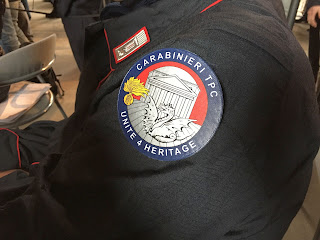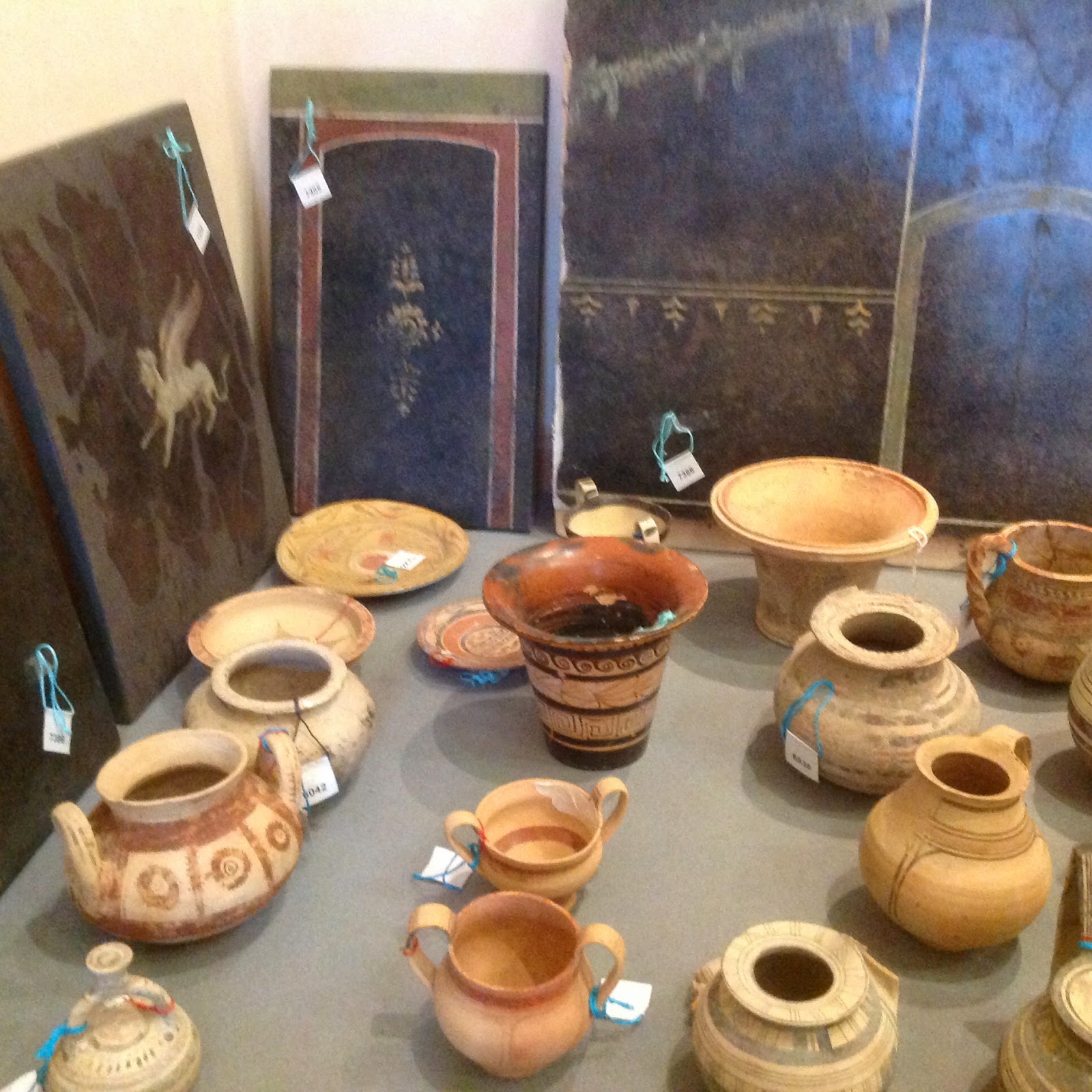(a fine testo, prima un video sulla nuova task force e poi una galleria immagini sulla distruzione dell'antica e celebre città di Palmyra, demolizione voluta dall'Isis)
"Una nazione è viva quando è viva la sua cultura". Con queste parole scritte in inglese e in antico persiano si è dato il via alla presentazione della prima task force operativa a protezione del patrimonio culturale mondiale, i Caschi Blu della Cultura
"Unite for heritage" che vede impegnati per primi al mondo i Carabinieri Tutela Patrimonio Culturale.
La frase fu scritta per la prima volta nel 2002 su un pezzo di stoffa appeso all'ingresso del Museo Nazionale dell'Afghanistan a Kabul, struttura salvata da saccheggi e distruzione, avviata alla sua ristrutturazione e restauro delle opere d'arte lì custodite. Un simbolo chiaro come risposta inequivocabile e ferma, è la nascita di questo gruppo che vede i militari dell'Arma appartenenti al suo nucleo specializzato, insieme a esperti del settore, studiosi e professionisti, pronti a operare in tutto il globo.
Ne dà notizia la stampa di tutto il mondo, tanti i giornalisti non solo italiani alla presentazione. Ne scrive l'organizzazione internazionale
ARCA (Association for Research into Crimes against Art)
in un suo articolo dettagliato.
Una presentazione, quella avvenuta oggi nell'aula X delle
Terme di Diocleziano – Museo Nazionale Romano, che ha visto la presenza di ben quattro titolari di dicasteri, del direttore generale dell'Unesco, del Comandante dell'Arma dei Carainieri, del sindaco di Torino: i ministri Dario Franceschini (Beni e attività culturali e del Turismo), Roberta Pinotti (Difesa), Stefania Giannini (Istruzione, Università e Ricerca), Paolo Gentiloni (Affari esteri e Cooperazione internazionale), la direttrice Unesco Irina Bokova, il generale Tullio Del Sette e il primo cittadino del capoluogo piemontese, Piero Fassino.

«Il patrimonio culturale è di tutti e tutti abbiamo il dovere di proteggerlo e difenderlo - ha detto il ministro Franceschini - La comunità internazionale protegga patrimonio culturale umanità. Siamo il primo Paese che mette a disposizione dell'Unesco una task force completamente dedicata alla difesa del patrimonio culturale mondiale e già operativa. Spero siano molti i paesi a seguire questa strada».
Il tutto fa seguito all'accordo firmato a ottobre 2015 e con l'approvazione di una risoluzione all'Unesco presentata dall'Italia e firmata da altre 53 nazioni.
«Il patrimonio del mondo non è più minacciato nel corso di un conflitto dalle azioni di guerra, come avveniva nella Seconda Guerra Mondiale - ha sottolineato Franceschini - Ora la distruzione viene filmata e usata come propaganda, a simbolo dell'eliminazione di una cultura diversa, per cancellarla. L'importanza dell'atto firmato oggi non è solo simbolica ma ben concreta».
Il generale Tullio Del Sette ha ribadito la lunga storia operativa del nucleo Tutela Patrimonio Culturale del carabinieri, «nato 47 anni fa (ndR: 3 maggio 1969), primo reparto al mondo dedicato a questo tipo di attività operativa».
I carabinieri Tpc sono stati messi a disposizione anche di diverse nazioni che ne hanno avuto bisogno a seguito di situazioni di grandi crisi», momenti che hanno messo in pericolo il loro patrimonio culturale e tanto per fare un solo esempio numerico, questo Nucleo dell'Arma ha recuperato fino a oggi circa 750mila beni culturali fra opere e reperti.
«Questa Task force contrasta la strategia del terrore seguendo un'azione tipicamente italiana che viene della strategia anti-terrorismo - ha sottolineato il ministro Gentiloni che riferendosi all'Isis ha continuato - Va contro quelle azioni che colpiscono luoghi-simbolo per eliminare la cultura di nazioni e, obiettivo ancora più insidioso, per cancellare la diversità e la pluralità che hanno caratterizzato e caratterizzano le civiltà e i popoli o la "pulizia culturale" dell'Isis in Medio Oriente, con le persecuzioni delle minoranze cristiane e yazide».
L'Unite for heritage può contare su circa 30 carabinieri specializzati e altri 30 tra storici dell’arte, studiosi, restauratori dell’Istituto Centrale del Restauro e dell’Opificio delle Pietre Dure di Firenze. Presto anche anche professori universitari che vogliono partecipare all'azione del gruppo. Da qui la scuola di formazione a Torino, anche questa nata oggi con la sigla del sindaco della città, Fassino.
Il capoluogo piemontese ospita già lo Staff College delle Nazioni Unite. Il nuovo centro di formazione dedicato ai Caschi Blu della Cultura si chiamerà Itrech (International Training and Research Center of Economies of Culture and World Heritage), fondato anche dall’Università degli Studi, il Politecnico, l’ILO/OIT, il Consorzio Venaria Reale e il Centro Studi Santagata che è storico collaboratore dell'Unesco. L’Itrech avrà come base il Campus delle Nazioni Unite che oggi dà sede anche al Centro Internazionale di Formazione dell’Organizzazione Internazionale del Lavoro, allo Staff College e all’Unicri, agenzia Onu per la lotta alla criminalità (United Nations Interregional Crime and Justice Research Institute).

«Siamo testimoni oggi di un dramma a livello mondiale – ha detto Irina Bokova, direttore generale dell'Unesco nonché possibile nuovo segretario generale Onu – la distruzione del patrimonio culturale, il dramma della pulizia culturale delle minoranze etniche e di ciò che le caratterizza. L'entusiasmo nei confronti dell'Italia è grande perché questo Paese si è reso protagonista di questa nuova iniziativa che contrasterà la depredazione e la perdita del patrimonio mondiale, un'Italia che ha già 54 siti patrimonio dell'umanità, grandi ricercatori, studiosi e i carabinieri che tanto ci assistono con la loro opera».
«Avverto oggi un grande senso di responsabilità per l'apertura di un nuovo capitolo per la protezione del patrimonio culturale - ha concluso la Bokova - Stiamo lanciando oggi un grande messaggio. Ecco le nostre risposte contro l'estremismo, risposte che devono essere la ricostruzione di un mausoleo, il restauro degli scritti della sapienza islamica, dalla matematica all'astronomia, la ricostruzione del ponte di Mostar».

Come specificato anche dal ministero, l'Unite For Heritage non agirà sui fronti di guerra perché la gestione dei conflitti non rientra nel campo operativo del gruppo. I Caschi Blu della cultura non saranno schierati, per esempio, a difesa dell'antica città di Palmira difendendola dall’Isis ma, su specifica richiesta dell’Onu, interverranno in momenti di gravi crisi civili, come durante un terremoto, ad esempio quello del Nepal, per porre riparo a emergenze legate al Patrimonio, oppure verificheranno i danni a opere e siti archeologici dopo un conflitto e dopo il ritiro delle truppe coinvolte. Potranno predisporre il trasferimento in luoghi di sicurezza di opere che potrebbero essere in pericolo e, naturalmente, contrastare i depredatori e trafficanti di reperti utilizzando ogni strumento, compreso il vastissimo database dei Carabinieri TPC che sta alla base di un vasto programma Interpol per la protezione del patrimonio culturale.
 Carabinieri Art Squad,Carabinieri Tutela Patrimonio Culturale,Italy,Museo Nazionale del Risorgimento,museum,museum theft,National Museum of the Risorgimento,Rome
Carabinieri Art Squad,Carabinieri Tutela Patrimonio Culturale,Italy,Museo Nazionale del Risorgimento,museum,museum theft,National Museum of the Risorgimento,Rome
 No comments
No comments
 Carabinieri Art Squad,Carabinieri Tutela Patrimonio Culturale,Italy,Museo Nazionale del Risorgimento,museum,museum theft,National Museum of the Risorgimento,Rome
Carabinieri Art Squad,Carabinieri Tutela Patrimonio Culturale,Italy,Museo Nazionale del Risorgimento,museum,museum theft,National Museum of the Risorgimento,Rome
 No comments
No comments

 from the museum would have likely drawn considerable attention. Instead, the shield simply vanished without a trace, only to resurface in the news as having been located in the private residence of a yet unnamed "Rome architect".
from the museum would have likely drawn considerable attention. Instead, the shield simply vanished without a trace, only to resurface in the news as having been located in the private residence of a yet unnamed "Rome architect". 























































